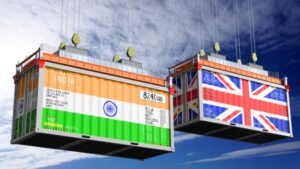Last month, one of the biggest Indian apparel retailers (having equally strong offline and online presence) sourced 3 million pieces from Jaipur. And it is further in the process to increase its sourcing multi-fold. Though the retailers’ sourcing is also increasing from other hubs, comparatively it is more as far as Jaipur is concerned. Similarly, the hub has good demand from wholesalers and other segments of domestic markets.
Currently, the Jaipur hub, having around 400 apparel exporters and 600 manufacturers and jobworkers for domestic market mainly, is doing an annual business of around Rs. 7,000 crore. The industry experts believe that the hub has full potential to grow its business at least by 3-folds and that too in the next 3 to 4 years.
One of the major reasons for this expected growth is that with the use of local crafts, value addition strengths, the ‘Pink City’ has developed strongly in the ethnicwear (for women) product category. At the same time, majority of factories have fewer overheads due to their small-scale operations. But with the help of jobworkers and overtime, these factories can do big orders also.
But this growth is from the domestic market only (for organised as well as unorganised apparel manufacturers). The heavy current demand is majorly due to the hope that Indian consumers will buy more in coming summer season as they missed the same in 2020.
The export, which was picking up before Covid, is currently sluggish and is also expected to be the same in near future. But in long run, there are enough chances that export will grow from here. Whenever the Covid phase will end, Jaipur will get more orders from the city itself as well as from global buyers who are sourcing smaller quantities from China. Exporters strongly believe that orders will come definitely to Jaipur as none of the other hubs has an equal perfect mix of small orders, local crafts and controlled overhead that Jaipur has.
For the time being, more exporters are catering to domestic clients to feed the capacities.
To further grow in export, local exporters and their associations are continuing their efforts – at the individual level as well as approaching Government strongly. Some of the efforts are continuing since last few years and growing, while few are at planning level only. One such initiative is focused more on recycled, sustainable garments and compliance.
Vimal Shah, President Garment Exporters Association of Rajasthan (GEAR) says, “Following compliance to ensuring no wastage, Jaipur’s exporters are trying their best to become eco-friendly and follow sustainability. To do it on a larger level and attract more buyers, we have requested the State Government to support for the development of green textile park which will promote sustainable garmenting and ensure the usage of recycled yarn and every possible aspect of the green supply chain. Afterall, in long-term, sustainability is going to dominate more.”
He further adds that if the Government supports this concept, it will not only ease and increase their efforts, but it will also add credibility to the buyers. He strongly believes that green aspect will motivate buyers to work more with Jaipur.
In fact some of the companies are already growing well just by following sustainability as their core strength. One of them is Sekawati Impex, which is known for its variety of bags.
Dinesh Gupta, CEO of the company says, “The idea of a sustainable or green textile park is a very good one as demand of eco-friendly products is getting momentum day by day. And I feel that small exporters have to follow this green concept to add value in their offering and fetch more orders.”
Having a turnover of Rs. 50 core last year, the company, also leading in CSR efforts, is able to add few new customers and foresees good expansion plans in the next 2 years. Its major focus is on GOTS-certified products now.
Majority of garment exporters in Jaipur are small exporters running small enterprises, where the investment in plant and machinery or equipment does not exceed Rs. 10 crore and the turnover does not exceed Rs. 50 crore. While very few are in the medium category (investment in plant and machinery or equipment does not exceed Rs. 50 crore and turnover does not exceed Rs. 250 crore).
So, due to small operations and more dependency on value addition and buyers which mostly place small orders, the majority of Jaipur’s exporters have to work on low volumes only and they have to manage the cost accordingly. There is also adoption of required technology which fits into exporters’ budget also. Unlike other apparel manufacturing hubs, Jaipur has the least exposure to technology. The city doesn’t have any technology expo nor is there any strong presence of machine suppliers or the opportunity to explore latest technology to have first-hand information or live demo.
To improve on this front, Jaipur’s apparel manufacturers and especially exporters have urged the Government to support for the establishment of a research or development centre where one can avail live demo of all kinds of available technology. It will motivate them to adopt the latest techniques as well as will improve the technical knowledge of industry professionals.
There are several other challenges too that Jaipur’s exporters are facing. “Timely release of refund, clearing subsidies and ease of doing business should be top priority of Government. It is very difficult for small exporters to complete the huge documentation process across various departments,” says Aseem Singla, Director, Fashion Images Overseas. The company is catering to the buyers of Japan as well as Australia.
As far as individual efforts of the exporters are concerned, over the years, Jaipur’s apparel manufacturers have successfully attracted local workers and especially women to work in factories and now around 20 per cent workforce belongs to local women. It is helping factories to be more disciplined and productive. With the help of various skill development initiatives, more local workers will join the industry and this will reduce the dependency of the industry on migratory workers. At the same time, the association is in touch with the Government to create dormitories for migratory workers to support them.
Along with garments (womenswear majorly) the exporters who used to do home furnishing, are now focusing more on home products and getting good response also. This is a balancing act for them so that they can support their business by doing the both segments together.
“Unlike previous year, even after Diwali, we do have good demand of home furnishing products from export as well as domestic market,” says the promoter of one of the top level companies of Jaipur who doesn’t wish to share the name. Having monthly capacity of 6 lakh pieces of garments and 4 lakh pieces of home furnishing products, it is one of the well-known companies of Jaipur.
Working mostly with the leading domestic retailers, the promoter adds further, “As we have overall good resources and good client base, we don’t see any major issue in overall working and certainly good growth is expected in future.”
As far as specific products are concerned, tunics are still dominating the domestic industry and are expected to remain so in the near future also as from last few years, this segment has been established as an identity of the ‘Pink City’. A value addition in this direction is that now more entrepreneurs are moving to sell through online.
Anuj Mundra, CMD, Nandani Creation Ltd., who is a pioneer in this regard and is leading with his platform www.jaipurkurti.com, has seen 3 times growth in the last few months as far as the online sales are concerned. “Few more companies are now moving in this direction as they have realised the importance of online sales. But they have to take it as a long-term business rather than just coping up with the down sentiments of offline sales. There is no dearth of opportunities for Jaipur-based apparel manufacturers in online sales.”
Across the globe, the demand for knitted garments and MMF-based products is more, but so far Jaipur has not been focusing on these fronts and even now most of the Jaipur’s exporters are reluctant to work in this regard as they are much keen to encash their core strength in cotton and value-added garments. They believe this to be a better bet for them rather than putting extra fuel in new directions, especially, when higher demand for knitted and formal garments is not for very long term.
Amongst all these aspects, there are apprehensions about the major sourcing from Jaipur being done by one retailer. In case of any unexpected move by domestic retailer and particularly one of India’s biggest retailers (mentioned in the beginning), it will have a very strong negative impact on the entire hub – and not to forget that this retailer was recently in limelight for not paying its vendors across India.
Jaipur is amongst the hubs, which sustained well long back and despite limits and apprehensions, it has full potential to grow. But for that, more individual and official efforts are definitely required.







